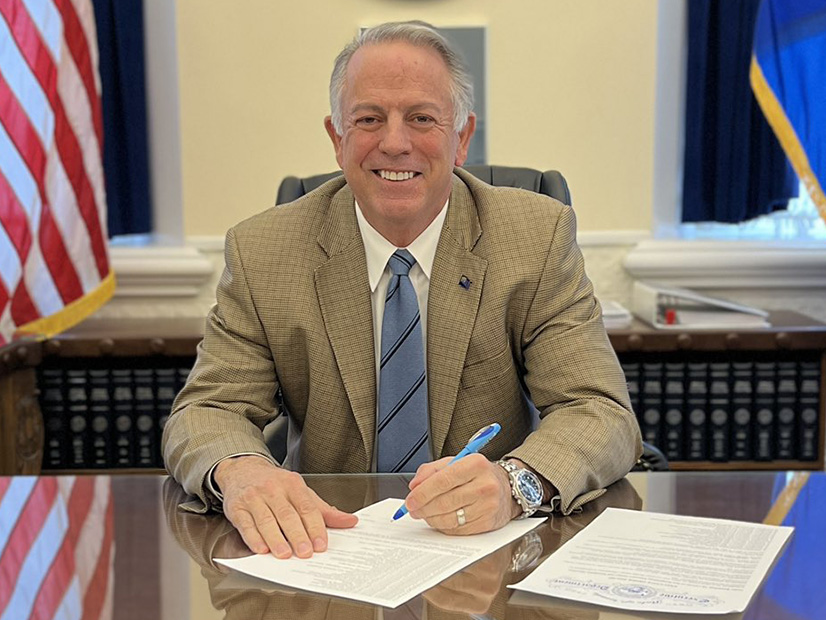Gov. Joe Lombardo has removed Nevada from the U.S. Climate Alliance, saying the group’s objectives conflict with his goal of developing a diverse energy portfolio for the state that includes natural gas.
The decision came to light as Arizona Gov. Katie Hobbs announced this week that the Grand Canyon State had joined the Alliance. Lombardo made no official announcement of Nevada’s exit from the Alliance, but Nevada’s absence from the group’s membership roster was noticed following Hobbs’ announcement.
“While the goals of the U.S. Climate Alliance are ambitious and well-intentioned, these goals conflict with Nevada’s energy policy objectives,” Lombardo said in a July 5 letter to U.S. Climate Alliance Executive Director Casey Katims, stating his decision to leave the coalition.
“These objectives are focused on developing and maintaining a diverse energy supply portfolio and utilizing a balanced approach to electric and natural gas energy supply and transportation fuels that emphasizes affordability and reliability for consumers,” Lombardo wrote.
Lombardo laid out his energy policies in a March executive order, including the state’s “advancement of energy independence.” (See New Governor Seeks Shift in Nevada Energy Policy.)
Nevada’s previous governor, Steve Sisolak, brought the state into the Alliance in 2019. Sisolak, a Democrat, was defeated in his reelection bid last year by Lombardo, a Republican.
Lombardo’s office didn’t respond to a request for comment.
Falling Short of GHG Targets
Formed in 2017, the U.S. Climate Alliance is now a bipartisan coalition with 25 members. Alliance members have agreed to work toward the Paris Agreement goal of keeping global temperature rise at less than 1.5 degrees Celsius. They collectively set a target to reduce greenhouse gas emissions by at least 26% by 2025 and 50% by 2030, compared with 2005 levels, and reaching net zero in 2050.
The GHG reduction goals are similar to those included in Nevada’s greenhouse gas inventory, an annual report required by state Senate Bill 254 of 2019.
The most recent GHG report, released this year, shows Nevada slipping further from those targets. The report details the state’s GHG emissions through 2020, with projections through 2042.
Nevada’s targets used as a benchmark in the report are a 28% reduction in GHG emissions by 2025 relative to 2005 levels; a 45% reduction by 2030; and zero or near-zero emissions by 2050. But the report projects only a 21.4% reduction in GHG emissions by 2025 and a 22.7% reduction by 2030.
And those reductions are slightly less than projections in the state’s GHG inventory from a year earlier, which forecast a 22.5% reduction in GHG emissions by 2025 and a 23.9% reduction by 2030.
In 2020, Nevada’s net GHG emissions totaled 37.3 million metric tons of CO2 equivalent, a 24.4% reduction from 2005 levels. GHG emissions in 2020 were less than the 2019 levels of 40.6 million metric tons. The report attributes the 2020 decrease to impacts of the COVID-19 pandemic, particularly on the transportation sector.
The transportation sector was the largest contributor to GHG emissions in Nevada, accounting for 32% of gross emissions in 2020, followed by electricity generation, which accounted for 31%.
For projecting future GHG emissions, the report makes several assumptions, including future retirements of natural gas-fired electric generating units. But the Public Utilities Commission of Nevada this year approved NV Energy’s request to postpone retirements of several gas-fired plants, as well as construction of a new 400-MW gas-fired peaker plant. (See NV Energy Rejected on Plan to Replace Coal Plant with Storage.)
Next year’s GHG inventory will likely factor in the recent PUCN decisions.
‘Door is Open’
Evan Westrup, communications director for the U.S. Climate Alliance, said Lombardo’s decision to leave the Alliance was disappointing, but “our door is open” if he changes his mind.
“As unprecedented wildfire smoke, record heat and catastrophic floods sweep across the country, we need every state and every governor — no matter their politics — confronting this crisis,” Westrup said in an email.
Westrup noted that newly elected governors in other Alliance states have opted to remain in the coalition, including the governors of Massachusetts, Hawaii, Oregon, Maryland and Pennsylvania.
Christi Cabrera-Georgeson, co-deputy director of the Nevada Conservation League, credited Lombardo for signing bills this year that will create more accountability and transparency in utility planning and promote clean energy.
But Lombardo’s decision to leave the U.S. Climate Alliance “contradicts these efforts and cedes Nevada’s leadership on clean energy and climate,” she said.
“This was a choice to prioritize utilities and their profits over everyday Nevadans who are already struggling to pay their energy bills amid record-breaking temperatures,” Cabrera-Georgeson said in an email. “By not prioritizing clean energy investments to diversify our job market and reduce greenhouse gas emissions, Nevada’s economy and environment will also suffer.”

